Effects of Childhood Bullying–The “Gift” That Keeps on Giving
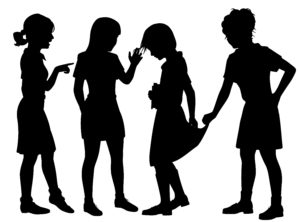 It seems to me that the world is being taken over by bullies. Just spend five minutes on twitter, and you’ll find examples of strangers trying desperately to squash other strangers with hateful language just because they have a difference of opinion.
It seems to me that the world is being taken over by bullies. Just spend five minutes on twitter, and you’ll find examples of strangers trying desperately to squash other strangers with hateful language just because they have a difference of opinion.
Bully Mentality Is Toxic
Det samme gælder for dem, der bruger stimulerende stoffer (såkaldte “poppers” som f.eks. amylnitrit) til rekreative formål. Det anbefales ikke, at Viagra Connect tages samtidig med riociguat og det antiretrovirale lægemiddel mandligmagt.com ritronavir til behandling af HIV/AIDS. Når du køber Viagra Connect, skal du give apotekeren en liste over alle de lægemidler, du tager regelmæssigt.
Then there are our world leaders. When two bully leaders face off (I’m not mentioning any names), things become more serious. People’s lives are on the line, as a competition ensues: which leader carries the biggest stick, a thinly disguised metaphor for which alpha male has the biggest …. hands.
Bully Mentality Can Be Deadly
It certainly can. Here’s a horrific example from a Washington Post article published just last month : “Three former executives of a French telecommunications giant were found guilty on Friday of creating a corporate culture so toxic that 35 of their employees were driven to suicide in the 2000s.”
Bullying cultures at work that lead to suicide? Is this what we’ve come to?
Bullying is not a new phenomenon, even though it feels, at least to me, that it’s entered into a “golden age.” This behavior has become expected, normalized, tolerated—and even in some circles, glorified. But the above examples feature men.
What About Women and Bullying?
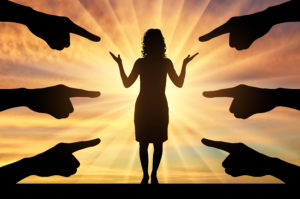
What about women and bullying? About sisterhood? Woman-on-woman bullying feels like an even greater betrayal. Haven’t we learned that we’re stronger when we stand together?
I decided to examine the topic of bullying, and especially woman-on-woman bullying last September. Shortly after I interviewed the amazing Mireya Vela, she texted me and asked if I would be interested in interviewing a woman—a woman we both knew and loved–who was being bullied by other adult women and had suffered great harm. I had no idea that our friend was so much pain. When I heard, I was horrified—and intrigued. I needed to learn more.
Of course, I was familiar with bullying on the playground. The adolescent trauma of cyberbullying was well documented, as was the incidence of teen suicide in its wake. I’ve seen Mean Girls—I mean, who hasn’t? I even knew about bullying in the workplace. But did women really, knowingly, deliberately cause such great harm to other women? Was this really “a thing?”
There Is Plenty of Woman-on-Woman Bullying in Adult Workplaces, Between Adult Sisters, Between Friends
I immediately began doing some research on the topic. I read articles, reached out to my WomanPause readership and to my Facebook friends. The more I read and the more people I spoke to, the more I learned that, yes, unfortunately, bullying doesn’t die once we graduate middle or high school. In fact, there is plenty of woman-on-woman bullying in adult workplaces, between adult sisters and family members, between friends.
Most of us can recall being the target of a bully at one time or another. For many of us, the pain is still raw. So, let’s examine the roots of bullying this week and how girls learn to bully so masterfully.
Let’s travel back in time, to that playground, to that elementary or middle school. We, as kids, wore our vulnerabilities on our sleeves. Most of us hadn’t learned about shame yet, and, those of us who had learned that lesson too young, still hadn’t discovered how to hide it.
Many Women I Spoke to Generously Shared Their Childhood Vulnerabilities with Me
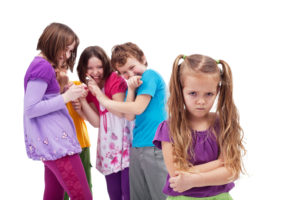 Sharing one’s vulnerability is a wonderful quality, but, too often, this openness sets a child up as an easy target for another child who’s seeking an opportunity to increase his or her own power at someone else’s expense.
Sharing one’s vulnerability is a wonderful quality, but, too often, this openness sets a child up as an easy target for another child who’s seeking an opportunity to increase his or her own power at someone else’s expense.
Many women I spoke to generously shared their childhood vulnerabilities with me. For Caren Lissner, journalist and author, it was not being able to afford the designer jeans and the “Madonna-style bracelets” that made her a target of verbal taunts by the other girls in her wealthy suburban neighborhood of Holmdel, New Jersey. (Please read her moving piece about her experience. She also wrote what she describes as a “nerdy novel,” Carrie Pilby. It was later made into a Netflix feature. Caren told me much of her writing is informed by her experiences of exclusion.) Lily Caraballo, also a writer, was bullied, too, because of the way she dressed or did/didn’t do her hair. Bunnarasy, a woman who came to the U.S. from Cambodia as a refugee in 1980, shared that her life-long experience with bullying began at the hands of an older half-sister.
Many, like writer/educator Patti LaLonde, whose family had a lot going on at the time, didn’t feel that there would be much support if they shared their experiences with their parents or siblings; others, like Andrea Auten felt there was nowhere to escape, as they were also bullied at home.
While Each of Our Specific Vulnerabilities May Have Been Different, Our Experiences Are All Too Similar
My own experience with childhood bullying started when I began to gain weight. Living in a chaotic household, I felt lost when my oldest sister, whom I looked to as my lifeline, got married and left the house when I was in second grade. I began to buffer myself by adding layers and layers of soft flesh to my body, as I self-medicated with quarts of orange juice and bread and chocolate sandwiches—lots of them. Rhonda, a tall, thin girl, who was not herself particularly popular, “befriended” me and then held me in her torturous bullying grip, until she moved when I was in 5th grade.
While each of our specific vulnerabilities may have been different, our experiences are all too similar. They were excruciating—and, for most of us, long-lasting. Not one of us could say that our having been bullied in childhood has not left its mark on us today.
Several women said that the bullying experience was one they grew from. Some, like Lily, said it made them better at setting limits and boundaries. Others said it made them tougher and more able to face adversity. Still others credit their experiences with fueling their creativity. Most say that their own pain has helped them become more compassionate, less judgmental of and more sensitive toward others. These are all good things, and I applaud growth from whatever source it springs. Still … aren’t there gentler, equally effective ways to grow?
“Victims of Bullying in Childhood Were at Increased Risk of Anxiety Disorders in Adulthood, and Those Who Were Both Victims and Perpetrators Were at Increased Risk of Adult Depression and Panic Disorder.”
 Most of the lasting effects of bullying cannot be seen in a positive light. Early experiences with bullying often cast shadows on women’s future relationships with other women. Patti LaLonde believes this has been the case with her: “I have a lot of trouble with super confident women. I automatically associate them with bullying, even though it doesn’t mean you’re a bully if you’re confident. It’s one of the things I strive for—to be super confident.”
Most of the lasting effects of bullying cannot be seen in a positive light. Early experiences with bullying often cast shadows on women’s future relationships with other women. Patti LaLonde believes this has been the case with her: “I have a lot of trouble with super confident women. I automatically associate them with bullying, even though it doesn’t mean you’re a bully if you’re confident. It’s one of the things I strive for—to be super confident.”
Patti is certainly not alone. Many people have remnants of mistrust and even fear from their experience of being a target, and these remnants can sometimes affect their mental health. William Copeland, in a study of adult outcomes of childhood bullying, found that, “Victims of bullying in childhood were at increased risk of anxiety disorders in adulthood, and those who were both victims and perpetrators were at increased risk of adult depression and panic disorder.”
“Bullying,” according to Copeland, “is not just a harmless rite of passage or an inevitable part of growing up. Victims of bullying are at increased risk for emotional disorders in adulthood.”
Phyllis Chesler would agree. Author of Woman’s Inhumanity to Woman, Chesler writes about the persistent rawness of what happened so long ago: “when my adult interviewees described being gossiped about and shunned by other girls in grade or high school, some wept and were surprised by the strong emotion the memory still evoked.”
The Pain–and Shame–of Being Bullied Can Last into Adulthood
Many of the women I spoke to about their experiences of childhood bullying shared that the old pain—and the shame—still runs deep. Andrea Auten, whom I interviewed just last month for the blog, found talking about her early experiences with bullying extremely difficult. A survivor of childhood sexual abuse, Andrea said that the shame she carries because she was bullied eclipses even the shame she’s carried from the abuse. For Andrea, the two events began at about the same time.
Andrea’s “personality changed,” as a result of the abuse. She “developed a relationship with lying—about everything” and also became extremely loud and talkative, which she believes made her a perfect target for bullies. (Andrea has long-since put her lying days to bed, btw.) Andrea grew up in a small midwestern suburb: “In the Midwest environment, we’re really hard on our children and each other. I didn’t have anyone I could go to. I was harboring a truth and not able to take it anywhere. My family was going through a rough time. I couldn’t go to my own mother. My brother became a bully. There were bullies everywhere. I couldn’t get away from it. It became my identity.”
Early Experiences with bullying Often Cast Shadows on Women’s Future Relationships with Other Women
Barbie Beaton, a writer who generously answered my call on Facebook to share her bullying experiences, has a lot in common with Andrea. Herself a survivor of adolescent sexual abuse, Barbie agrees that the effects of childhood bullying had an even greater impact on her early adult relationships than did the sexual abuse: “I didn’t have deep relationships with women. Guys were just easier to be around. I didn’t feel I could trust women.”
Barbie spent much of her life unaware that she had been bullied. She recalls feeling “inexplicably unhappy” into her adulthood. But it wasn’t until she started writing a memoir that an epiphany hit. While she had previously chalked up much of the pain she had experienced at the hands of her sisters and mother to being the middle child, Barbie suddenly realized the cause was much deeper than that: she had been the target of constant bullying in her own home.
Naming the Monster, Helps One Tame the Monster
When Barbie was able to put a name to her experiences, the work of healing could begin. She had gained important insight into her life, but at the same time, her whole sense of reality had been yanked out from under her. After working through much of the trauma, Barbie saw an “amazing and beautiful shift.” Once she began to tell her story, she developed “deep, authentic, and supportive relationships with women. I couldn’t write without that.”
Barbie has two daughters of her own. She’s thrilled that she is breaking the cycle: “I am so grateful to have daughters because I can give them a different experience. Every time they spend time together and say I love you makes me feel I’ve done something right.”
Internalizing the Bully
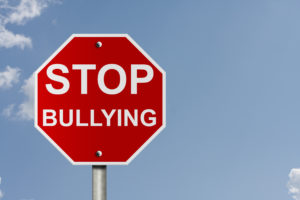 I believe my own childhood experiences with being bullied has had a lasting effect on my self-esteem, especially when it comes to body image. I have a distorted image of my body and of what my size, whatever it happens to be in the moment (or the month, or the year), means to the outside world. Because I was brutally taunted about my weight when I was a child, whenever I carry around several excess pounds, I still feel like the world is judging me.
I believe my own childhood experiences with being bullied has had a lasting effect on my self-esteem, especially when it comes to body image. I have a distorted image of my body and of what my size, whatever it happens to be in the moment (or the month, or the year), means to the outside world. Because I was brutally taunted about my weight when I was a child, whenever I carry around several excess pounds, I still feel like the world is judging me.
While I recognize this judgement is, in part, due to real cultural biases around people of “a certain size,” I run with those judgments and take them to a whole other level. The fact is, the world is not paying all that much attention to me—or to my size! But I have internalized all those negative messages, all of that shame. I, thankfully, have not experienced much adult bullying from other women. But I have more than made up for that by bullying myself!
I Never Made Bullying a Way of Life, But I Cannot Say That I Am Innocent
What about the childhood bully? While most of us remember being targets, how many of us took the other role too? I have. I never made bullying a way of life, but I cannot say that I am innocent. Lucy Martin, a girl from Czechoslovakia, was my target. She spoke with an accent. She was taller and slimmer than the rest of us and was more physically mature—she was the first to get zits and greasy hair.
I had made Lucy my friend. And then I turned on her. I would stare at her in class with a horrible scowl and a disgusted look, trying to get my eyes to bore right through her. It wasn’t the worst torture that she endured, I’m sure, but my betrayal may have stung more than most. Because I had been nice to her and then blindsided her, I may have inflicted the greater wound.
Why did I do that? What did I gain? A moment of power over someone whom I considered weaker than I was? That “moment” has cost me—dearly.
Meanness Never Comes from a Place of Feeling Good About Oneself
I have tried to find Lucy online, several times, to no avail. I still carry my guilt, my own shame about my behavior and want so much to apologize. The bully hurts too.
There is room for compassion for childhood bullies. Meanness never comes from a place of feeling good about oneself. Bullies have often been bullied themselves, often at home. Bullying can be learned behavior. It can also be their toxic way of dealing with feeling “less than.” I’m not suggesting we bring out the violins for the bullies among us, just that, like in any relationship of power abuse, everyone suffers.
So … girl-on-girl bullying. Let’s examine some of the tricky dynamics. (We’ll take a deep dive into woman-on-woman bullying next time.)
Queen Bees
The blockbuster movie Mean Girls was based on another blockbuster, Rosalind Wiseman’s book Queen Bees and Wannabees. In case you haven’t read it, or want a refresher, here are the roles in girl-on-girl bullying drama:
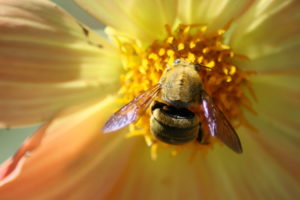 The Queen Bee. Oh, what pain she inflicts—and what power she holds! Here’s a section from Wiseman’s book in which she describes this supreme leader: “Through a combination of charisma, force, money, looks, will, and social intelligence, this girl reigns supreme over the other girls and weakens their friendships with others, thereby strengthening her own power and influence. Never underestimate her power over other girls (and boys as well).”
The Queen Bee. Oh, what pain she inflicts—and what power she holds! Here’s a section from Wiseman’s book in which she describes this supreme leader: “Through a combination of charisma, force, money, looks, will, and social intelligence, this girl reigns supreme over the other girls and weakens their friendships with others, thereby strengthening her own power and influence. Never underestimate her power over other girls (and boys as well).”
Queen Bees Are Not the Only Ones Who Sting
We all remember a Queen Bee growing up. Many of us envied her and wanted more than anything to be her friend. Some of us were her targets. Others played one of the following roles.
- The Sidekick. According to Wiseman, she’s the “lieutenant or second in command, the girl who’s closest to the Queen Bee and will back her no matter what because her power depends on the confidence she gets from the Queen Bee. Together they appear to other girls as an impenetrable force.”
The two appear incredibly similar, but the difference between them, according to Wisemen, is that apart from the Queen Bee, the Sidekick can be a kinder person. The Queen Bee, on the other hand, “would be more likely to find another Sidekick and begin again.”
- Then there’s the Banker. She may be an underling, but never underestimate what she can do. The Banker collects information—remember knowledge is power!—and “dispenses it at strategic intervals.” Just when the Queen Bee needs a juicy piece of gossip, or when she may be becoming too soft on one of the Banker’s rivals, the Banker lets the Queen Bee in on the scoop, solidifying her own place of importance.
- The Messenger. She’s often mistaken for a peacemaker. While The Messenger dispenses the information she collects to try to keep peace, her motivations are less than pure. She uses her role to to rise up in the hierarchy of the hive, “to gain recognition and social power.”
Some Girls Never Grow Out of Their Roles
So, bullying among girls is some nasty—and complicated—business. And the effects on its targets can last a lifetime. Unfortunately, these roles can also last a lifetime. Some “mean girls” never grow out of their roles. They become adult Queen Bees with years of experience under their belts. And the damage these women can do to others is often devastating.
We will examine the woman-on-woman bullying in two weeks.
In the meantime, I’d like to say thank you to all the women who have participated in this bullying project! And to those who may not have, I’d love to hear your thoughts.
What roles, if any, have you played in the girl-on-girl bullying drama? How have you freed yourself from that role? And how has the experience of childhood bullying informed your adult life and your relationships with other women?
See you Monday, February 3rd!
Diane



Diane, Good work and research and interviewing! I went to middle school and high school in Honolulu and was one of 7 haoles (white people) in middle school. There was some bullying by badass Hawaiian girls (who ratted their hair and kept razor blades in it), but I was not targeted. In high school I studied a lot and ran track. Never seemed to fit in with the “in crowd” but was not targeted either. It was the workplace where I experienced a lot of female bullying and jealousy (in offices). I neutralized this bullying by running at lunch (the bullies HATED that) and quit several jobs due to this adult female bullying and gossiping by mediocre workers nonsense. They should have all been fired but corporate HR’s and male leaders were clueless and useless. Excellent blog! Looking forward to Part 2!
Thanks, Diana, for sharing your workplace experiences of female bullying–and your unique way of dealing with it! I hope Part 2 will resonate with you as well!
Hi Diane, I look forward to your second installment on this most interesting subject. I am still trying to figure out if I was more a bully, a bullied or an observer – I’m sure one of all three at different times.
xox
Thanks, Janet! I think many of us spent some time in each of the different roles. It is interesting to figure it all out.
Diane, Thanks for this thought-provoking exploration of bullying. As usual, your angle is unique and helps us think about the topic in new ways. I was a “sidekick” for sure in grade school and middle school. I was drawn to extremely confident girls because I had no sense of my own identity. Although I outgrew my sidekick status by early high school, I had the identity struggle until my late thirties.
I was bullied in grade school by one cruel boy but it was the girls who rallied around me. I always felt SO fortunate that I’ve had positive experiences with girls and women if not with boys and men. I feel the deepest sadness for those who were betrayed by what should be a sisterhood of support. Thank you to all the brave women who shared their stories for this article. May you live free from the lingering effects of nasty behavior that you did nothing to deserve.
Sherry
Thank you Sherry for your comment and for your heartfelt words for our sisters.
Terrifying.
When you asked about bullying earlier, I could think only of the time in 3rd grade that I bullied a kid on detention. I wrote about the impact I still feel from thae incident, but I couldn’t think of any other times of being bullied or bullying. It’s strange, but having to move to a series of different towns seemed its own kind of disorientation. If kids didn’t like me it was that I was unknown. I didn’t perceive bullying.
Perhaps growing up in Mennonite-influenced areas made a difference. Oh, we had every inclination to bully each other, but the religion didn’t approve. In fact, in small towns with religious climates, bullying may have been buried underground. Um, the religion itself was a fairly constant–if outwardly kind–switch.
Bullying was still alive, though. My older sister, a tall girl before that was popular, did experience some classic bullying. But that brings up the differences between high school classes. For some reason, the kids in my class (in the town where we landed) were really nice and still are. Each hs class seems to have its own atmosphere. Those of us, at a particular school in the class of 1966, were the beneficiaries of dumb luck.
I’m looking forward to your next post.
Thanks for your thoughtful comment, Greta. Sometimes being spared really is a matter of “dumb luck.” Whether it be your community, the religious “switch,” your particular class, I’m glad you were spared!